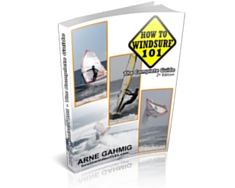The waterstart: portal to the small volume boards. The manoeuvre that separates the men from the boys, real windsurfers from the newbies, the dedicated from the dabblers…. The waterstart is THE manoeuvre you need to get a hang of to truly enjoy the sport of windsurfing.
If we remember my post on the beachstart, I mention that the beachstart is 95% technique and 5% wind. The waterstart is 80% technique and 20% wind. This means that we can still do a waterstart easily even if the wind drops. However, I have seen so many people unable to sail back to shore when the wind dropped just because their waterstart technique was useless. Therefore I recommend that everybody read this even if they know how to do the waterstart.
The technique of the waterstart is very similiar to that of the beachstart. Basically you can think of the waterstart as a beachstart without touching the ground. Therefore I recommend getting the beachstart technique sorted out before you tackle the waterstart.
Pulling the sail out of the water
I wrote a separate article on how to get the sail out of the water for the waterstart and positioning the gear to save time and energy. You can read up on it now and come back to this post later or finish this one first. For now the main piece of information I want to to take away is that you make sure you keep the sail flat on the water surface to avoid the end of the boom sticking in the water and undoing all your progress of getting the sail to hover out of the water.
Now to the actual waterstart:
We position the board similar to the beachstart, beam reach or slightly more downwind for more sail surface (if there is little wind). We get the board into this position with the same pushing/pulling on the mastfoot as the beachstart only that we need the keep our body more tense as we don’t have a ground to use as fixed point.To get and maintain the board in place we can hold the boom or mast with the front hand and the back footstrap with the back hand.
With these two contact points we can lever the board into place. We can either move on to the next step immediately if we have enough wind or, if we don’t have enough wind, wait for a gust strong enough to lift us out.here is what comes next: Once we have the gear laid out correctly we put the back foot on the board. If there is enough wind we can put both feet on the board which will give us greater control. However, if we use only one foot we can use the other leg to swim upwards and help us get on.
A very important note, when you put your foot on the board DO NOT push the board away from you. You want to lay the foot on the centerline of the board and pull it towards you if anything. Pushing the board away with the back foot will cause the board to turn into the wind and leave us luffed up so far that we no longer have any wind lifting us.
So: lay the back foot on the centerline of the board and push with your front hand onto the mastfoot through the mast. As soon as the foot is on the back hand goes from the back footstrap to the boom (if you didn’t have there already). Once there do not immediately pull down. What you want to do is pull the back hand upwards towards the mast top. Basically over your head. Our intention is to keep the boom horizontal throughout the whole procedure.
As you do this you want to bend your knees and lean your shoulders forwards so that your chest is touching your knees. What this does is in essence position the sail as vertical as possible while bringing your weight centre as low and close over the board as possible. The result is as much sail surface available to the wind to lift us up and the minimum resistance of your bodyweight to pull us down.
Do not sabotage yourself
As soon as we start to get lifted out it is important to avoid two things:
– Bend the front arm
– Lunge forwards with our hips
Both of these will sabotage our efforts and make us fall backwards into the water again. Try to keep this in mind:we want the sail to lift us out of the water with the wind. We DON’T want to pull ourselves up as we would doing pull-ups.
Once our body’s weight centre is over the board we must start to open the sail again to avoid being catapulted over the other side.
And to top it all off we need to keep the boards position steady throughout the whole procedure. As you can see, it is quite a complex maneouvre indeed and one that takes a while to be mastered. I would definitely recommend getting an instructor to guide you for the first two hours as keeping all of these things in mind is nearly impossible… Also, it will stop you from taking up bad habits (especially the front arm and hip lunging thing).
So, to recap:
– Board on beam reach or slightly downwind
– Wait for wind gust if not enough constant wind
– Foot resting on the board, not pushing the board away
– Front arm straight and leaning the mast forward
– Bend knees
– Shoulders forward
– Let the sail lift us up and NOT pull ourselves up
– Open the sail in time
– Maintain board direction steady throughout all manoeuvre
Again, here is the post on lifting the sail out of the water.








Well written. Love the introduction: dedicated from the dabblers. Clearly written with a sense of self-irony and brought a smile to my face.
Hey there, You’ve done an incredible job. I’ll definitely digg it and in my view suggest to my friends. I am confident they’ll be benefited from this website.
I have been reading out some of your articles and it’s pretty clever stuff. I will make sure to bookmark your website.
I loved as much as you’ll receive carried out right here. The sketch is tasteful, your authored material stylish. nonetheless, you command get bought an impatience over that you wish be delivering the following. unwell unquestionably come more formerly again since exactly the same nearly very often inside case you shield this increase.